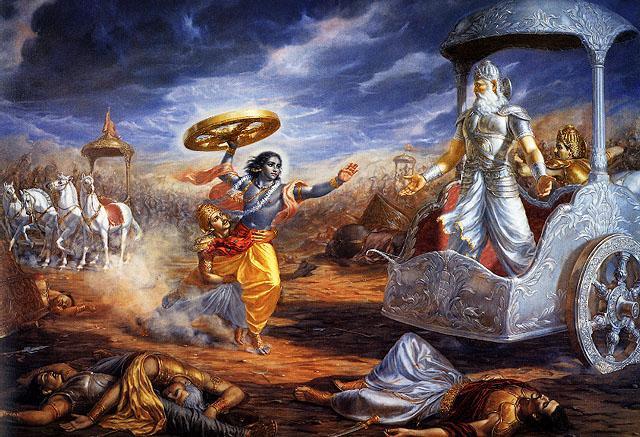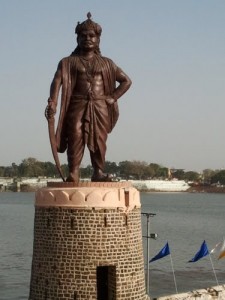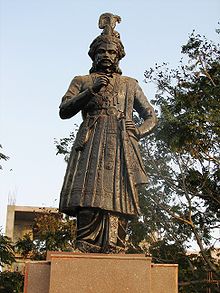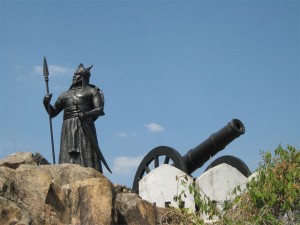[box_light]Vajra Mushti (Sanskrit vajramuṣṭi वज्रमुश्टि) is a Sanskrit bahuvrihi compound translating to “one who is grasping a thunderbolt” or “one whose clenched fist is like a diamond”. It is a name of Indra mentioned in the Ramayana epic[/box_light]
Prior to his training in Brazil in the late 80’s, author and Brazilian Jiu Jitsu Black Belt, John Will, travelled to and trained in some of the most exotic places in Asia and the sub-continent.It was during those travels, that he sought out and trained with the notorious Jyesthimalla clan in the desert state of Gujarat in India.
 The beginning of the no-rules Vajramushti match – complete with ivory-carved knuckledusters worn on the right hand of each combatant. The beginning of the no-rules Vajramushti match – complete with ivory-carved knuckledusters worn on the right hand of each combatant. |
Training
The Jyesthimallas are the keepers of this ancient and formidable art; an art in which a knuckleduster is tied onto the wrestlers right hand and used in ways that would make the hardest UFC veteran, wince in disbelief. This art form is by no means, a modern day adaption of the wrestling and striking arts; it has a history, a lineage and traditions that take us back to the middle ages and possibly beyond.
 Vajramushti wrestling techniques included working from the bottom position – in recent times, Brazilian Jiu Jitsu has brought similar strategies into mainstream focus. Vajramushti wrestling techniques included working from the bottom position – in recent times, Brazilian Jiu Jitsu has brought similar strategies into mainstream focus.
|
The Mallapurana
Indian culture has produced a plethora of Puranas, (ancient texts), ranging from writings on ancient ayurvedic medicine, classical architecture, from warfare to lovemaking – and these collections of ancient wisdom have been written, re-written and handed down from generation to generation till modern day.
One such Purana, the Mallapurana is kept at the Oriental research Institute in Poona, India. It is written in the Devangari script and dates back to the year 1731 A.D. It describes many of the practises and traditions of the Vajramushti wrestlers in particular; some of which will be described in this article. It also mentions the Jyesthimalla’s or Jyesthi clan of fighters, who still carried on the practice of this art into recent times. The term Jyesthi translates as ‘the best’ and comes from the word Jyestha meaning most prominent or seniormost. The Jyesthimallas still inhabit the Gujarat region of India till this day – two renowned Jyesthimalla’s were Shri Sitaram and Laxminarayana Sagar, both pictured in this article.
This ancient Mallapurana text contains eighteen chapters, describing everything from the diet, training practices and stages of the fight in detail. From the syntax and spelling of certain words contained therein, there is evidence enough to suggest that it was copied in the 1700’s from another, even older source that may have dated back to even centuries earlier.
The word Mallapurana is a term derived from two words; Malla – meaning wrestler or fighter and Purana – denoting ‘ancient or old story’. Hence, Mallapurana, refers to the ancient works denoting the practices of fighters or wrestlers.
 The victor has won the match by locking up his opponents weapon arm – note that the lock applied in this case is almost identical to the ‘Omoplata’ of modern day brazilian Jiu Jitsu. The victor has won the match by locking up his opponents weapon arm – note that the lock applied in this case is almost identical to the ‘Omoplata’ of modern day brazilian Jiu Jitsu.The Training |
The Mallapurana describes the various types of exercises the wrestlers would undertake to condition themselves for the fight. Among these are:
- The Rangasrama – refers to the actual wrestling and wrestling techniques. These include all manner of grappling techniques, such as takedowns, fighting from the bottom, fighting from the top, and striking techniques.
- The Sthambhasrama – the set of exercises performed on a standing upright pole called a Sthamba. There are many kinds of Sthamba, although the most common is an upright pole, some eight to ten inches in diameter, planted into the ground. The wrestler performs various complex callisthenics on it to develop arm, leg and upper-body strength and stamina.
- The Gonitaka – this refers to the training done with a large stone ring. This weight is lifted and swung in various ways, even worn around the neck to develop neck, back and leg strength.
- The Pramada – is the set of exercises performed with the use of the Indian clubs – the Gada. These tools are still used by many Indian wrestling Akhada (wrestling schools) today.
- The Kundakavartana – refers to the callisthenics performed without the use of equipment; tumbling, various styles of push-ups, squats, etc that are used to develop overall strength and stamina.
- The Uhapohasrama – refers to the discussion of tactics and strategies and is considered an important part of the fighters training regime.
The training of boys did not begin till they were about ten or twelve years of age. Initially, they were taught just the callisthenics and exercises to develop both strength and stamina. Much importance was placed on Baithakas, or squats and Dandes, or Indian pushups.
Once the student has developed sufficient strength, flexibility and stamina, he is introduced to the Mallasthamba or wrestlers pole, where the power to grip, with both arms and legs is developed to a high degree. There are many ways in which the wrestler mounts, utilizes and dismounts this free-standing pillar. Alongside these main methods, practices such as swimming and running were also used to further prepare the fighter to train in actual wrestling techniques and eventually, competition.
The wrestling or fighting training was done in the Akhada, usually a circular or square area of some thirty feet across, filled with soft soil. The earth in the Akhada is kept soft by constant tilling and by the addition of various substances, such as ochre, buttermilk and oil. Water is usually sprinkled over the training area, about every third day.
 Here are some examples of the various Vajramushti – the two smaller weapons are used for the sporting aspect, whilst the larger, complete with spiked ends, were used in warfare. Here are some examples of the various Vajramushti – the two smaller weapons are used for the sporting aspect, whilst the larger, complete with spiked ends, were used in warfare.
|
The Vajramushti
In this fierce style of wrestling, the combatants wear the Ayudha or Vajramusti on their right hand. This weapon, commonly known today as the knuckleduster, is usually made out of buffalo horn or ivory. It has several small holes along it’s length, so that it may be tied onto the hand with thread, so as not to become dislodged during the fight.
A weapon similar to the Vajramushti, was also used in the ancient Greek and Roman world. It was used by boxers and Pancrationists, and was called the Cestus. It was a ring, usually made of bronze, worn around the knuckles, to add power to a blow. Many variations of this weapon have been described in both ancient Greek and Indian literature.The Vajramushti’s that were used in warfare had sharp spikes or blades extending from each end.
In training, the Vajramushti wrestlers are taught many ways to lock-up and immobilize the arm that holds the Vajramushti. These locks are applied with the arms, or legs and sometimes a combination of both. Various methods of striking and defending are also part of the mainstream training regimen. Takedowns, knees and elbows are also employed – although striking with the weapon to any target below the chest is considered an illegal technique.
 The author in the mid 1980’s,alongside renowned Jyesthimalla wrestler, Shri Sitaram, wearing the Vajramushti. The author in the mid 1980’s,alongside renowned Jyesthimalla wrestler, Shri Sitaram, wearing the Vajramushti.
|
The Vajramushti Match
On the day of the match, the combatants heads are shaved clean, except for a small tuft of hair on the crown of the head. Several Neem leaves are tied to this tuft of hair as a good luck omen. The wrestlers body is then rubbed down with red ochre, which is supposedly mean’t to keep the body cool during the fight.
Before leaving their family Akhada for the match, both fighters pray to their family Goddess, Limbaja. For this worship, a square altar is temporarly constructed in the middle of the wrestling pit, upon which a branch of the Neem tree is planted. To the east of this altar, a small platform is placed, upon which, the weapons of the wrestlers are placed.
After prayers and rituals are completed, the fighter is given the Vajramushti, which is tied to his right hand. Upon leaving their family’s place of training, the wrestlers make their way to the public areana, where they enter in a zig- zagging, jumping fashion.
The object of the match was to bring the other fighter to the point of submission; either by blows or a locking up of the Vajramushti-wielding arm. It is a limited-rules engagement, where knees, kicks and strikes are all legal techniques to be used in conjunction with grappling techniques .
Both fighters receive payment after the match, with the winner receiving double the amount of his defeated opponent. If the match was a draw, and neither fighter was submitted, then the prize was shared.
 The author with another Vajramushti wrestler, just prior to a training session in a renowned Jyesthimalla Akhada. The author with another Vajramushti wrestler, just prior to a training session in a renowned Jyesthimalla Akhada.
|
The Jyethimallas
The Jyesthimalla’s are now found in the Indian states of Gujarat, Mysore, Hyderabad and Rajasthan. In Baroda, the capital of Gujarat, several of the better known Jyesthimalla’s have kept training Akhada’s right up to present day. The Jyesthi’s are a sub-caste of the Modha Brahmins, and as such worship the Indian deity, Krishna.
It is interesting to note that the Jyesthimalla’s have been referred to in ancient literature, as far back as the 12th and 13th centuries. They have always had the distinction of being Ayudhajivi Brahmanas, that is Brahmins (the priest caste) living on arms.
The Jyesthi’s living in the 16th century were renowned athletes, and thought of as being synonomous with fighting. In fact, to this day, there is an expression in the state of Gujarat, ‘the Jyesthimallas are fighting’, and it is used to describe any serious duel between two combatants.
The Jyesthi’s have had a long tradition of working as bodyguards to marriage parties, and have been patronised by kings, princes and rulers for many centuries.
In the early 19th century, the Jyesthimallas were sponsored by the Gaekwads, and so, many were invited to Baroda from Dalmal and Hyderabad. Those that came from the Hyderabad continued to maintain their family’s fighting tradition right up until modern day; but sadly, by the late 1980’s there were only several surviving practitioners of this ancient art still living in Baroda. Even then, it was an art on the verge of extinction.
 The 1st page of the Mallapurana text preserved at the Oriental Research Institute in Poona. The 1st page of the Mallapurana text preserved at the Oriental Research Institute in Poona.
|
Conclusion:
In this the 21st century, we see ourselves at the very pinnacle of evolution in as far as the combative arts go. And this may well be the case – due not to the effort of any single individual, but rather to the advent of the information explosion. We simply have more information at our fingertips today, than we have ever had in the history of mankind. Via the internet and cable television, any 15 year old can keep abreast of what is happening at any given moment. The magazine racks are crammed with publications to cater for every taste. Martial arts schools flourish on every corner.
But it has not always been this way. To put things in context; only twenty years ago, nobody outside of Brazil had heard of Brazilian Jiu Jitsu or Vale Tudo. Forty years ago, the term ‘Kickboxing’ hadn’t even been coined yet. Sixty years ago, no-one had ever heard the words ‘Karate’ or ‘Kung Fu’ outside of the Orient. In other words, our history of professional mixed martial arts is a very short one indeed; some would say, even non-existent.
It is worth the effort, at least in my opinion, to peer back into time, and examine arts such as those practised by the Vajramushti fighters, and marvel at the sheer wonder and history of it all. Over centuries, such arts were developed, who knows to what amazing degree; for no video cameras existed and no cable television networks were there to broadcast the struggles of these time-forgotten athletes.
It takes several decades, and the work of many, to develop an art to the point where it’s level of effectiveness outweighs it’s theoretical musings – but sadly, with the passing of only one generation it can all be forgotten as if it had never existed at all. The world is growing smaller; history and legends fade by the minute – but if we pay attention and keep our hearts open, much can still be preserved.
– John B Will
(8134)



 However some thoughts rankled in my mind. If the Hindus were truly slaves for a thousand years plus, then how have we survived to this day with dignity and honour and with a spiritual tradition stretching back to the mists of time and beyond? Many other cultures, civilisations and spiritual traditions have been reduced to museum pieces, but the words of the Holy Vedas are recited in an identical fashion today as they were thousands of years ago when first revealed to the Rishis.
However some thoughts rankled in my mind. If the Hindus were truly slaves for a thousand years plus, then how have we survived to this day with dignity and honour and with a spiritual tradition stretching back to the mists of time and beyond? Many other cultures, civilisations and spiritual traditions have been reduced to museum pieces, but the words of the Holy Vedas are recited in an identical fashion today as they were thousands of years ago when first revealed to the Rishis. Following the death of their founder, Muhammad we see the Arab Khilafat expand swiftly over the Middle and Near East, pouring over the deserts of North Africa and crossing the waters to begin a six century occupation of Spain and beyond. The combined might of Christian Europe struggled again and again to reclaim the ‘holy lands’ to end in bitter failure with the rise of the Ottoman Empire, who ruled over a large part of Eastern Europe for centuries.
Following the death of their founder, Muhammad we see the Arab Khilafat expand swiftly over the Middle and Near East, pouring over the deserts of North Africa and crossing the waters to begin a six century occupation of Spain and beyond. The combined might of Christian Europe struggled again and again to reclaim the ‘holy lands’ to end in bitter failure with the rise of the Ottoman Empire, who ruled over a large part of Eastern Europe for centuries. Two further centuries passed as further advances were resisted until a breakthrough around 1200 CE allowed the invaders access to the North Indian plains. The remaining Buddhists were slaughtered or converted in an unprecedented orgy of violence and horror. The majority Buddhist regions of Afghanistan, Kashmir and West Punjab joined the crescent banner of Islam. However the conversion of Hindus was slower and the resistance was more fierce. Hindu warrior clans kept up a relentless resistance fighting from the deserts, the mountains and the forests. The heavy cavalry of the Muslim Turks which had proved fatal to the Crusaders of Western Europe were victorious on the plains of North India but this did not prevent an endless cycle of attack and counter attack by the Hindus.
Two further centuries passed as further advances were resisted until a breakthrough around 1200 CE allowed the invaders access to the North Indian plains. The remaining Buddhists were slaughtered or converted in an unprecedented orgy of violence and horror. The majority Buddhist regions of Afghanistan, Kashmir and West Punjab joined the crescent banner of Islam. However the conversion of Hindus was slower and the resistance was more fierce. Hindu warrior clans kept up a relentless resistance fighting from the deserts, the mountains and the forests. The heavy cavalry of the Muslim Turks which had proved fatal to the Crusaders of Western Europe were victorious on the plains of North India but this did not prevent an endless cycle of attack and counter attack by the Hindus. The religious traditions of India had been severely mauled by the endless bloodletting over the past two centuries. Many important institutions and temples were destroyed. Prosperity suffered, as it tends to in times of continuous war. This created a certain weakening of Hindu society. Religion became preserved in rituals which were less and less understood. Sanskrit learning was on the decline. Caste became more rigid.
The religious traditions of India had been severely mauled by the endless bloodletting over the past two centuries. Many important institutions and temples were destroyed. Prosperity suffered, as it tends to in times of continuous war. This created a certain weakening of Hindu society. Religion became preserved in rituals which were less and less understood. Sanskrit learning was on the decline. Caste became more rigid. Other larger organised resistance emerged in the Vijaynagara Empire of South India around 1336 CE which consolidated Hindu resistance for over two centuries. In the north the revival of the Rajput kingdoms and the defiance of kings like those of Orissa under the Gajapati Kings, the hills of Punjab under Jasrath Khokhar and the rise of neo Hindu kingdoms in the north east of India along with the entire hill region signaled the revival of Hindu rule over vast tracts of India.
Other larger organised resistance emerged in the Vijaynagara Empire of South India around 1336 CE which consolidated Hindu resistance for over two centuries. In the north the revival of the Rajput kingdoms and the defiance of kings like those of Orissa under the Gajapati Kings, the hills of Punjab under Jasrath Khokhar and the rise of neo Hindu kingdoms in the north east of India along with the entire hill region signaled the revival of Hindu rule over vast tracts of India. He instead moved away from the tenets of Islam to a new faith of the Din i Ilahi. By following the age old traditions of religious toleration in India he endeared himself to the majority population and through a period of compromise and alliance brought a brief period of peace to the troubled land.
He instead moved away from the tenets of Islam to a new faith of the Din i Ilahi. By following the age old traditions of religious toleration in India he endeared himself to the majority population and through a period of compromise and alliance brought a brief period of peace to the troubled land. The march of western civilisation ended the Hindu revival at a time when Hindus exercised control over almost the entire subcontinent. But it took Three wars with the Marathas, two wars with the Gurkhas, war with the Jaats, also smaller ranging wars with the Santhals, Sanyasis and many others .
The march of western civilisation ended the Hindu revival at a time when Hindus exercised control over almost the entire subcontinent. But it took Three wars with the Marathas, two wars with the Gurkhas, war with the Jaats, also smaller ranging wars with the Santhals, Sanyasis and many others . However the theories propagated by the British found challengers from the Hindus. Spurred by a revaluation of their history and the knowledge of western theories a new revival began to take fruit. From the universal preaching of Swami Vivekananda to the guns of the Anushilan Samiti the Hindus were at the forefront of a growing anti colonial challenge to the most powerful empire in the world. Finally finding control of the subcontinent untenable in the teeth of endless opposition the British Indian Empire collapsed in a wave of unprecedented bloodshed which has seen a slow and steady spread and reach of the Hindu world.
However the theories propagated by the British found challengers from the Hindus. Spurred by a revaluation of their history and the knowledge of western theories a new revival began to take fruit. From the universal preaching of Swami Vivekananda to the guns of the Anushilan Samiti the Hindus were at the forefront of a growing anti colonial challenge to the most powerful empire in the world. Finally finding control of the subcontinent untenable in the teeth of endless opposition the British Indian Empire collapsed in a wave of unprecedented bloodshed which has seen a slow and steady spread and reach of the Hindu world. Attack after attack was defeated. Horrific massacres did not force the people to abandon their religion and identity. The destruction of holy places did not see dharma die but rise again and overcome their opponents with the power of truth. The banner of freedom was raised generation after generation despite the best attempts of some vested parties to blur the truths and sacrifices made again and again.
Attack after attack was defeated. Horrific massacres did not force the people to abandon their religion and identity. The destruction of holy places did not see dharma die but rise again and overcome their opponents with the power of truth. The banner of freedom was raised generation after generation despite the best attempts of some vested parties to blur the truths and sacrifices made again and again.